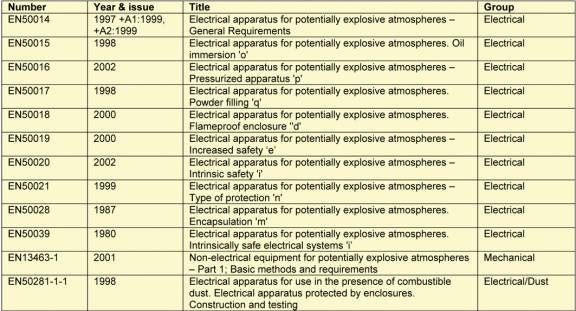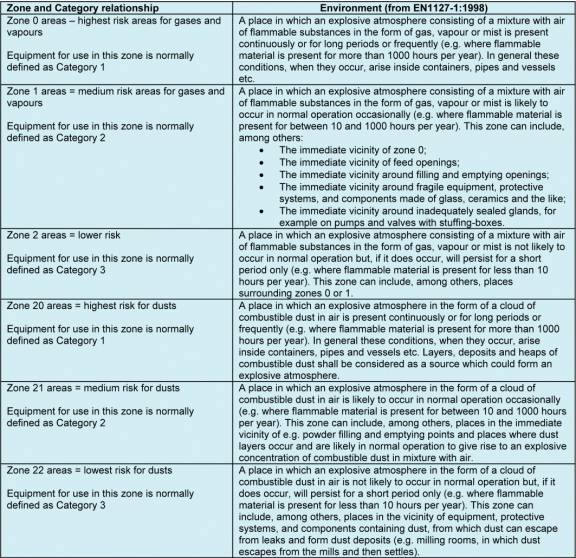|
Countdown to July 2003 ATmosphere EXplosive
By Simon Barrowcliff, Director Safety, TRL Compliance Services Ltd
With the two ATEX Directives set to become mandatory in July 2003, Simon Barrowcliff, Director Safety at TRL Compliance Services Ltd, describes the key features of the new regulations and the impact it will have on equipment manufacturers and end users. TRL Compliance Services Ltd has been appointed by the DTI as a Notified Body under the ATEX Directive.
Designed to open up free trade across Europe, the ATEX Directive 94/9/EC (ATmosphere EXplosive) sets out to align technical and legal requirements across member states for equipment and protective systems used in potentially explosive atmospheres. It will undoubtedly create opportunities and difficulties for manufacturers of equipment for use in these areas.
Putting the onus on the manufacturer, from 1 July 2003 it will be mandatory for all electrical and mechanical equipment used in potentially explosive atmospheres to be compliant with the ATEX Directive 94/9/EC. The burden also falls on the end user with a second ATEX Directive 1999/92/EC and its requirement to assess an area for explosion risk.
Previously there has been no obligation to use certified equipment or to grade an area as potentially explosive, merely to conform to the Health And Safety At Work Act and satisfy the Health and Safety Executive. Most users found that requesting third party certification on any equipment specification was the easiest way of showing that they met these safety requirements. Now, despite an eight-year transition period, there is still a large group of manufacturers who are completely unaware of the new directive and how it will affect their operations.
There are also new requirements for users. By using substances ranging from solvents through to flour, most manufacturing and process industries generate potentially explosive atmospheres. ATEX Directive (1999/92/EC) - also known as European Directive 137 or the “ATEX Use Directive” – covers the health and safety of workers at risk in these areas and makes it mandatory under European law to assess for an explosion risk and classify accordingly. This Directive has recently been ratified and will be compulsory under European Law from July 1 2003.
Once an area is classified as potentially explosive, the “Use Directive” requires only equipment suitable for safe operation under those risk conditions to be used. It has been widely interpreted by enforcement and legislative bodies that equipment certified in accordance with ATEX 94/9/EC fully meets this requirement and hence should be used in all new installations. The “Use Directive” will almost certainly increase the amount of ‘Classified or Zoned’ areas and, therefore, increase the demand for ATEX certified equipment. There is thus opportunity for manufacturers to develop equipment to satisfy this increased demand.
The ATEX Directive (94/9/EC) – also known as ATEX 100a and ATEX 95 – allows movement throughout the European Union by harmonising technical and legal aspects of equipment and protective systems for use in potentially explosive atmospheres. The Directive has been in existence through statutory regulations in the UK since March 1996 since when manufacturers have been in a transitional period. It is a New Approach (CE mark) directive and follows the same framework as used for other product directives, including EMC, Radio and Telecommunications Terminal Equipment (R&TTE), Machinery Safety, Low Voltage (LVD), Pressure Equipment (PED and Medical Devices (MDD).
The ATEX Directive (94/9/EC) forces manufacturers to gain certification of electrical and/or mechanical products to be used in potentially explosive atmospheres created by the presence of flammable gases, vapours, mists or dusts. Products without the appropriate certification are not legal and cannot be placed on the European market after July 1 2003.
This directive applies to equipment and protective systems in potentially explosive areas below ground, on the surface and on offshore fixed facilities. Implemented in 1996 through the Equipment and Protective Systems Intended for Use in Potentially Explosive Atmosphere Regulations, the new Directive does not affect equipment which is already installed and in use. And, at present, under the 1996 regulations, products ‘not placed in the market’ are exempt from the Directives – this can be products or equipment made by companies for their own use or by a manufacturer specifically for one end user.
ATEX Directive (94/9/EC) replaces the old ‘Explosive Atmospheres and Gassy mines Directive’ (76/117/EEC). There are serious implications for specific groups of manufacturers for whom specific explosion protection legislation now applies for the first time. The new directive brings under control three types of equipment. These are:-
· non-electrical equipment (e.g. mechanical equipment) · equipment for use in dust atmospheres (e.g. equipment for flour or saw mills) · safety related devices (e.g. vent systems, flame arrestors, suppression systems) and safe area equipment
From 1 July 2003, all equipment and protective systems must be marked legibly and indelibly with the name and address of the manufacturer, CE mark and number of Notified Body, designation of series or type of equipment, specific explosive protection ‘Ex’ hexagon logo, year of manufacture and serial number. (See example certification coding diagram below)
For CE marking, as well as compliance with ATEX, all hazardous area equipment must comply with any other applicable directives – such as the EMC Directive, R&TTE Directive or even the Low Voltage Directive. However, the CE mark does not prove ATEX compliance as, currently, some hazardous area equipment may be CE marked through compliance with other mandatory directives.
Under the ATEX directive manufacturers must design and test components to prevent or minimise the risk of explosion due to the production or release of explosive atmospheres. Essentially, manufacturers must consider every possible electrical or non-electrical source of ignition. And, at the same time, consider all potentially hazardous environments a product could operate in; the different ways it could be applied and the technical ability of the person using the product.
As with all new regulations, all new products must be assessed and all existing products reassessed. There are two distinct elements to gaining product approval – Product Type Approval (testing and assessment) and Production Control (quality systems in manufacture).
The former involves compliance with the Essential Health and Safety Requirements (EHSRs) described in Annex II of the directive. Electrical equipment is well covered, but few standards cover non-electrical equipment. Production Control involves a Quality Assurance type procedure often with the responsible manufacturer being audited by a Notified Body for compliance with the relevant annex dependent on the type of equipment and QA system currently in place.
The route to compliance with EHSRs will see most manufacturers choosing to prove conformity with the latest edition of the harmonised standards for electrical equipment for use in potentially explosive atmospheres. (See list of ATEX standards for accreditation purposes below)
Manufacturers should also supply other evidence of compliance such as proof of a consideration of issues such as general electrical safety and EMC. New standards are currently being introduced at a rapid rate, almost monthly, covering such concepts as equipment for use in potentially explosive dust atmospheres, mechanical hazard standards as well as new editions of the electrical equipment standards.
Under ATEX, all products must be categorised by the level of protection they offer against the risk of becoming a potential source of ignition in an explosive atmosphere. Defined categories for equipment conformity are divided between surface and mining applications. The “Use Directive” describes Zones to reflect the explosion risk. There are also specific zones for dust environments. The definitions of Category and Zone are interrelated. (See table – ATEX Zones, Categories and Environments below)
The ATEX Directive makes Notified Body involvement mandatory in both equipment assessment and monitoring of production for equipment for use in zone 0 areas (i.e. highest risk) and for equipment to be used in Zone 1 areas (i.e. medium risk). For equipment to be used in Zone 2 areas only (i.e. least risk) the manufacturer has to maintain technical documentation which includes evidence of testing and production control, although a Notified Body is not involved. This type of equipment may appear to meet the requirements without having been subjected to full test or certification procedures, hence users and buyers of Category 3 equipment should check with the supplier to ensure that the evidence of conformity is acceptable. Category 1 equipment may be used in Zones 0,1 and 2. Category 2 equipment may only be used in Zones 1 and 2. Category 3 equipment may only be used in Zone 2.
Just like with all other new directives, manufacturers must be made aware of their obligations as well as how to apply the new rules and regulations and use them to take advantage of the open market-place ATEX offers. As with all CE marking directives, there is a need for education. A good proportion – around 70% of manufacturers with existing certification are well-versed, are already working along the right lines and are in the process of re-certification.
Under the new CE mark regime, the onus on compliance is with the manufacturer so technical documentation belongs to the customer, rather than the Notified Body. By keeping the process as open and clear as possible, a manufacturer has choice and can use the market to their best advantage.
Simon Barrowcliff can be contacted on: Tel: 01695 556666; Fax: 01695 557077 or email: simon.barrowcliff@trllvd.co.uk http://www.trlcompliance.co.uk/
|


